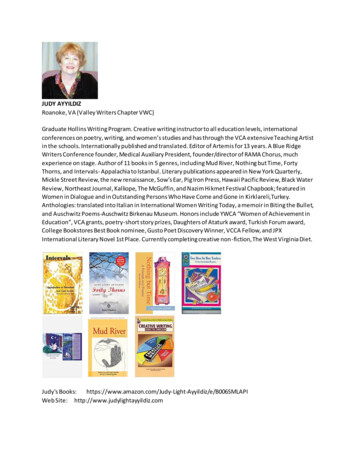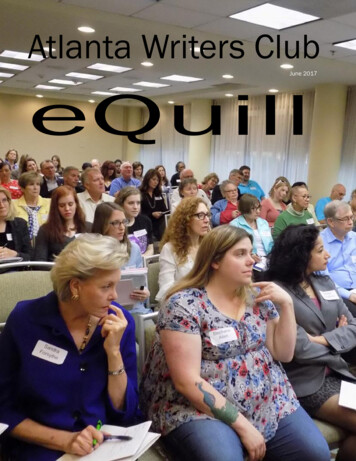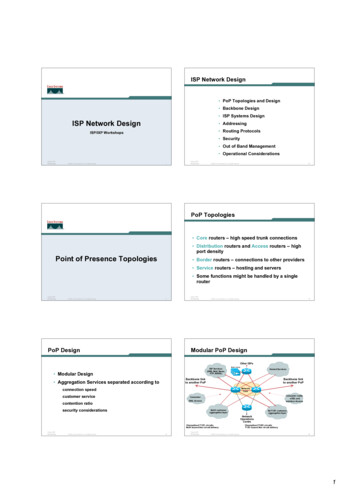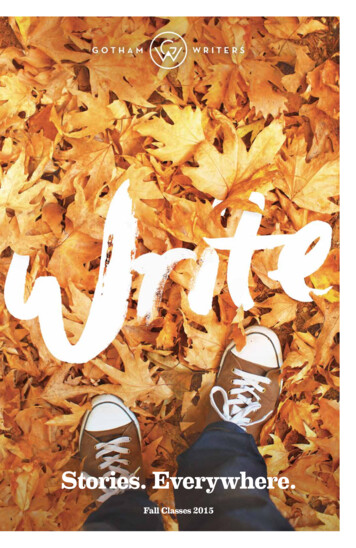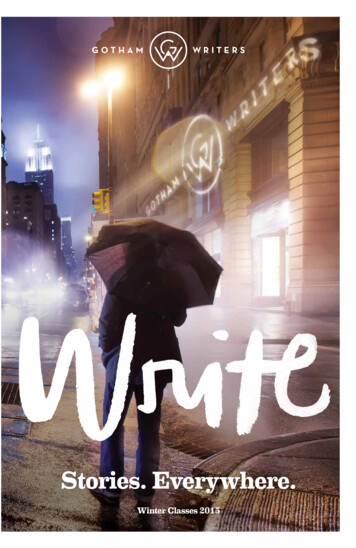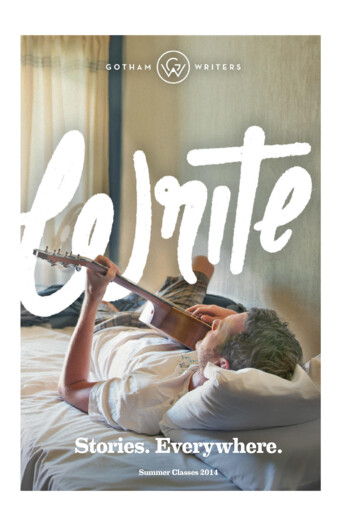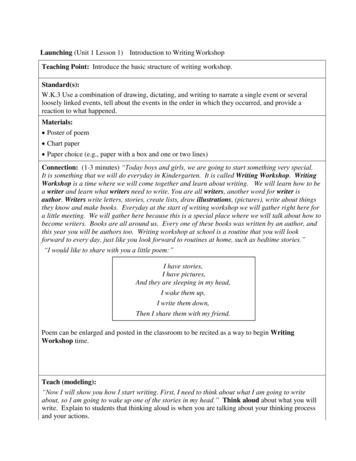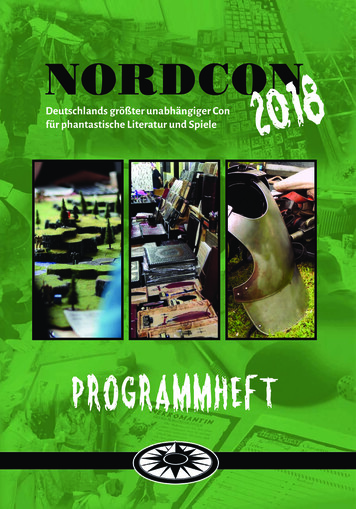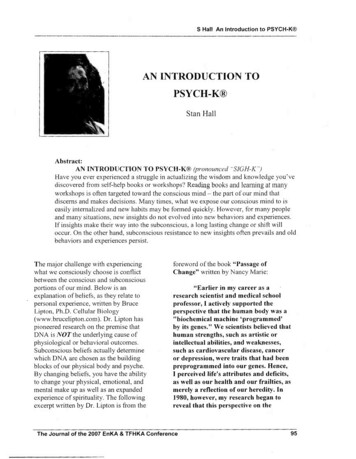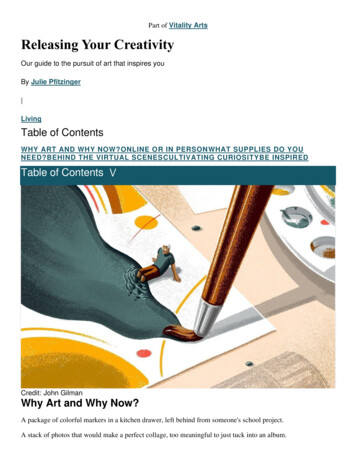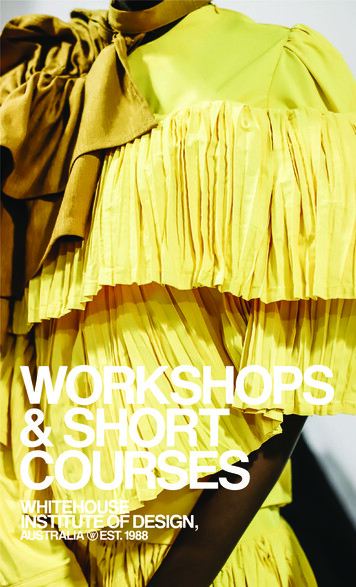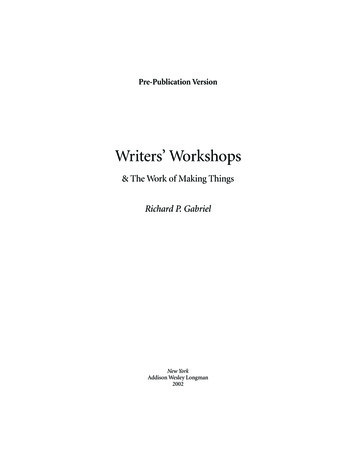
Transcription
Pre-Publication VersionWriters’ Workshops& The Work of Making ThingsRichard P. GabrielNew YorkAddison Wesley Longman2002
For John P. Gabriel,builder and inventor, who gave up ambitionto concentrate on life
AcknowledgementsI belong to two writers’ communities: the software patterns writers’ communitywhich is eagerly creating a new—and new type of—literature in the world ofcomputing and software, and the Warren Wilson MFA Program for Writersalumni, the Wallies. Each of these two communities is generous beyond anythingxenia could predict and more than a modest writer like me deserves. If you are awriter, then you know what kind of communities these are, and if you aren’t, youcan’t imagine the warmth, support, and generosity spawned by the work of tryingto write what is impossible to write.When I asked these two communities about their thoughts on the writers’workshop, I was flooded. Literally the size of my manuscript nearly doubled inlength with the advice and stories I got, and the reminders of what I once knewbut had forgotten. I would like to thank them first:Beth Thomas, Bob Hanmer, Bobby Woolf, Brian Marick, Bridget BalthropMorton, Browning Porter, Bruce Anderson, Carolyn West, Dave West, DawnO’Dell, Dirk Riehle, Don Olson, Faith Holsaert, Gerard Meszaros, Ian Wilson,James O. Coplien, James Reed, John Gribble, John LeTourneau, John Vlissides,Jutta Eckstein, Kathy Collisson, Ken Auer, Kent Beck, Klaus Marquardt, LaureAnne Bosselaar, Lauren Yaffe, Linda Rising, Mari Coates, Mark Solomon, MarkusVölter, Martha Rhodes, Martha Carlson-Bradley, Margaret Kaufman, Neil Harrison, Norm Kerth, Priscilla Orr, Ralph Johnson, Rebecca Rikner, Richard Helms,Richard Schmitt, Steve Fay, and Ward Cunningham.James O. Coplien and Bobby Woolf wrote down the writers’ workshop processas we first practiced it in the software patterns community (“A Pattern Languagefor Writers' Workshops,” in Pattern Languages of Program Design 4), and NeilHarrison wrote down how to shepherd (“The Language of the Shepherds: A Pattern Language for Shepherds and Sheep,” unpublished but on the Web), each inIII
IV/WRITERS’ WORKSHOPWork in Progressfine pattern languages—without these I would have had to actually rememberwhat we did and learned.Linda Elkin provided detailed and provocative comments on the manuscriptfor this book, and without her help it would have been a feeble book indeed.I particularly would like to thank the teachers who tried their darnedest toteach me to write: Heather McHugh, Stephen Dobyns, Michael Collier, and Thomas Lux. At Warren Wilson College, Ellen Bryant Voigt and Peter Turchi combined to create the most congenial and productive writers’ workshops I have everencountered. The following were some of my workshop leaders at writers’ workshops around the USA:Brenda Hillman, Sandra McPherson, Jane Hirshfield, Walter Pavlich, GarySnyder, Pattianne Rogers, Bob Hass, Ed Hirsch, Gerald Stern, Mark Strand, Timothy Liu, Mark Jarman, Carl Philips, Tom Andrews, Marianne Boruch, EleanorWilner, Tony Hoagland, Steve Orlen, Joan Aleshire, Agha Shahid Ali, ReginaldGibbons, Larry Levis, Campbell McGrath, Renate Wood, Brooks Haxton, MichaelRyan, and Alan Williamson.And especially: My friend Guy L. Steele Jr. kept me alive, my partner Jo A. Lawless kept me loved, my daughter Mika Toribara and son Joseph Tracy kept meyoung, and my long-time colleague and close friend Ron Goldman kept me honest (sort of).
PrefaceIn November 1999, Paul Becker of Addison-Wesley-Longman approached me at aconference in Denver and told me I was the perfect person to write a book on thewriters’ workshop. I thought he was nuts. He thought I was nuts back. We wereboth right. He was thinking of a book only for the software world—a primer onthe writers’ workshop as I had introduced it there. I was thinking of a book forboth software people and “real” writers. I was sure there were plenty of booksabout the writers’ workshop: There are books about every aspect of writing exceptmaybe how to sharpen pencils. But not so—I couldn’t find much that talkedabout the writers’ workshop and how it worked.1I told him to forget it anyway.He emailed me a few times.Forget it.After the third or fourth email I was starting to believe it might be fun since Ihad been thinking about how to address both audiences at once. I finally agreed.But I missed all his deadlines, and the draft I sent him in July of 2001 was OK,but minimal. We had agreed on a short book, but I had sent him a chapbook.Then I asked the two writing communities I am in—the alumni of the WarrenWilson College MFA Program for Writers and the design patterns community—to tell me what they knew about the writers’ workshop, and I was hit by a tsunamiof stories, advice, and ideas. Many of them were so good that I left them mostly intheir words. It’s part of the writers’ tradition of stealing (but I did ask if it wasOK). Writing a book on writers’ workshop brings one dangerously close to the possibility of writing on writing and creativity in general. There are already many bookson those two topics. I am an expert in neither, certainly not as measured by eduV
VI/WRITERS’ WORKSHOPWork in Progresscation and research. I am a practitioner of both, though, and I’ve approached thisbook from the outlook of a simple laborer in those areas. There are theories oflearning, ideas developed by composition theorists—I could have looked intohow theories of creativity and selfhood play into the workshop, or how to applystage-development theory and philosophy to the problem of how to help a writerbecome autonomous. I could have delved more deeply into cultural, racial, andgender issues in the workshop. These would be good things to do, but they are notthe good things I am able to do well.I know what it feels like to try to learn how to write, how to be a musician, howto create new ideas. Not being blessed with much talent to begin with, I think I’vemade do with what I was given well enough to be proud of it. And to think I havesomething to share about the road I took.I don’t know if this book will be useful for you, but I hope it will be. I can tellyou I had a great good time writing it, and sometimes—but not now—I wished Inever had to stop.rpgRedwood City2002
/1 ’ WorkshopCrowdThe Work of Making ThingsWork in ProgressThe GiftThe PlayersThe SettingIn SituPreparing for the WorkshopShepherdsThe Author ReadsFly on the WallSummarize the WorkPositive FeedbackSuggestions for ImprovementClarificationsWrapping UpRevising the WorkCoda: The Work of Making 1103107115121131137147151155167175189201
2/
IntroductionThroughout my years of schooling, I received Ds and the occasional Cin my English courses. My confidence in my ability to write was quitelow as I entered my first writers’ workshop. It’s true I had spent yearsworking on improving my writing on-the-job, but I still carried thescars from my teachers’ assessments of my inability to express ideas asan adolescent.During my virgin writers’ workshop experience, I learned something about my particular paper, what worked well, what was confusing, etc. But beyond those interesting pieces of feedback, I learnedsomething more important—I learned I could write something thatothers appreciated.This workshop, healed my scars, savagely inflicted upon my youngmind by English teachers who knew harsh feedback was good for me.This experience gave me the confidence to write a book, which is nowpublished and selling well.–anonymous, but it could be you Writing is one of the craziest things to do—it’s hard, and often what gets writtensurprises the writer. After the hard job getting a draft, the writer is elated and theresult reads great—a masterpiece in the making and a life of fame and accolades;the writer can do anything. Then the writers’ workshop.For many people the expectation of their first writers’ workshop is that it willbe a glorious affirmation of the talent and skill of themselves as a writer, but formany at the end of the writer’s first workshop experience there is emptiness—theexperience neither has affirmed nor condemned. For some there are tears, doubts,shame. For a few there is only the question: How could I have ever felt I had talent?The writer goes on, or the writer quits.3
4/Work in ProgressWRITERS’ WORKSHOP The writers’ workshop has been in use for decades by fiction writers, poets, andwriters of creative nonfiction, and in the realm of creative† writing it is praised asessential and criticized as vicious, loved and hated. Like any long-lived institution,the writers’ workshop has drifted from its origins, and some of the aspects thatmake workshops wonderful have been rubbed away or replaced by others havingless effectiveness or good will—that is, like all magic bits, the magic has beenworn off as the energy of its practice dissipates.In 1994 the writers’ workshop had a rebirth—in another field, with entirelynew participants, and in a setting where the magic both reappeared and wasunderstood. Since 1994 the writers’ workshop format has been in use by the software patterns community, both as a way to improve patterns and patternlanguages2 and as a way to share knowledge and experience, as a sort of alternative to presentations and standard scientific workshops.The patterns community experienced the writers’ workshop mojo right away,but the important news is that this particular community, perhaps like few others,has the habit and practice of trying to understand and articulate why beautifulthings are beautiful and why comfortable things give comfort. The workshop—something wildly new and unconventional to them—was studied and its nuancescaptured.What makes the writers’ workshop tick is roughly what makes large opensource software projects tick, where sometimes hundreds or thousands of programmers are working with shared source code. We see it in creative brainstorming sessions where a diverse group is brought together in fast-communicationsituations. We can also see it in the swarming behavior of all sorts of groups whereorder emerges where there once was chaos.But knowing how and why a thing works when it works is different from beingable to make it work any given time. The writers’ workshop works through sociology and psychology; it is only as good as its participants; its direction depends onthe work at hand and the order it is read; it can spin cruelly wrong; but it usuallybrings out the best in us. The writers’ workshop is bundled paradoxes: the private act of writing mixedwith group criticism, the gift economy of shared works mixed with mercenary† I use the term “creative” to distinguish the “creative writing” community from othercommunities that write. These other communities are full of highly creative people. Whenyou see phrases like “creative writing” and “creative workshops,” read them as jargon.
Work in ProgressINTRODUCTION/5workshop moderators, and generosity of supportive comments in a forum thatseems better suited for cutting people down.Writing is an intensely private, solitary act; the writers’ workshop is one of thefew parts of the process where the public—the other in the guise of colleaguesalong with strangers—is invited in. For the writer new to the writers’ workshop, itappears to be a forum where the writer, infallible and exhausted, faces the firstcheck, the first test of the work itself, and given these expectations, the test can beharsh. Where moments before the feeling was total power, during and after thefeeling may be total incompetence.But writers experienced with the workshop bring work they are unsure of butfeel contains a kernel perhaps without direction, and the workshop helps findthat direction. Before the workshop they feel uncertain about the work, but afterit they are brimming with new ideas and enthusiasm. Workshops are where writers gain invaluable advice and feedback, and in the best of circumstances, workshops are where writers learn to trust themselves and grow beyond the workshop.The work goes on, the words improve, the ideas are sharpened, what wasimportant is made bold, what is irrelevant is trimmed, the awkward matures tograce. And the transformation from pure thought to thought-in-words on thepage goes on.The arc from doubt to elation and omnipotence to doubt to completion iscommon to all creative activities. Its absence is the prime symptom of a mere job,rote engineering, repetition. That something like the writers’ workshop is neededin this process needs explanation. In this book I hope to answer this question andmore.We will look at the writers’ workshop process, and I will point out as best I canwhat conditions are required for it to work. I want to try to provide an understanding of how it works, and lay out a roadmap to its workings both as a ritualand as experience—how to run one, how to participate in one, how to surviveone, and how to use it to further your own work. I come from a background of both the arts and sciences: My principal educationand activities are from the world of mathematics and computer science; my second education and avocation is creative writing—poetry, in fact. I have experienced the writers’ workshop in both realms. In creative writing it is a moreemotional experience because the stuff that’s on the page perhaps means more tothe writer as a person than does the more technical and “objective” stuff on thepages written by a software developer, computer researcher, or manager. In creative writing, the discussions tend to be about the narrative structure, what thepiece is about, how it is constructed, craft elements and how to improve them,aesthetic concerns, and the positions and stances of the narrator and audience. In
6/Work in ProgressWRITERS’ WORKSHOPthe technical world, the experience is more antiseptic—a little more about thestuff than about the person, but not overwhelmingly so—and objective; the discussions tend to be more about the facts presented, the accuracy of the claims, thetechnical and scientific basis for judging the correctness of the material, and lessabout presentation and aesthetics, even though the strength and intention of thewriters’ workshop is to the writing.The writers’ workshop is a dance, and without knowing the steps a participantmight trip, even fall. Feet could be sprained or even broken—one should neverparticipate in a writers’ workshop without an introduction to it of some sort andthe ground rules being set. You need a moderator or workshop leader—someonewith experience and even better, expertise in the workshop and a master writer.The feet that are most badly hurt will not be those of the experienced, but those ofa new writer, a young person, and it’s not out of the realm of possibility that acareer might be changed by the wrong kind of statement at the wrong time. Theconversations in a writers’ workshop are not a debate, not a chat, not an argument, not a forum to show off, not a flame war, not a love-fest, not a shoutingmatch, not a lecture, not a demonstration, and certainly not a cakewalk.But the young writer is not the only one at risk: I’ve seen seasoned writers—poets with hundreds of poems in their portfolio and dozens of writers’ workshopsbehind them—break down, run from the room in tears, leave a conference thatwas devastatingly unaffordable after the wrong two or three comments. I havewatched senior computer scientists with dozens of publications turn bright brightred in embarrassment and then anger. The workshop is a crucible in which everypart of the human equation is tested: creation, destruction, leadership, control,privacy, exhibitionism, voyeurism, love, hatred, fear, collaboration, cooperation,order, chaos, victory, devastation, humility, pride, shyness, bravado, and spirituality. For technical people, the raw emotion is surprising, for the creative writer theclinical coldness is alarming.The writers’ workshop, though, when it works well works better than almostanything else at getting to the best work in the shortest time. If you’re trying to getquickly to the release of a usable work, you will get there faster without the writers’ workshop process, but if your goal is the best work, the writers’ workshop willget you there faster. Through this book, I hope to introduce or reintroduce the ideas of the writers’workshop to a wide audience: to writers new to the workshop, to writers whowant to understand how the workshop works, to new writers who want to findout how to get good fast, to veteran workshopper who have experienced too manyof the bad parts of workshops, to technical people and scientists who have never
Work in ProgressINTRODUCTION/7thought of their work as including writing, to business people looking for betterways to improve collateral material and presentations, and to software developers.For creative writers for whom the writers’ workshop has perhaps grown staleand drifted from its roots—by talking about how and why it works, I hope torekindle your faith in it and help you find a renewed focus on the work and on thegifts the workshop represents.For scientists and technologists already using the writers’ workshop, I hope tobring you some of the insights of the creative writing community on writing andtheir more pedagogical use of the workshop so you can use the workshop moreeffectively and more thoroughly. The book is broken into two major parts, introduced by a two-chapter overview.To understand why the writers’ workshop can work requires an idea or a model ofwriting and the writing process. I have no choice but to give you my view of writing and process, and I hope you’ll recognize some aspects of it in the work you do.For both creative writers and scientists it is a creative act with risks involved. Thesection of the book that covers these topics is called “The Work of MakingThings.”The second part of the book explains the steps in the writers’ workshop andprovides stories and examples of what goes on in the workshop. This section ofthe book is called “Writers’ Workshop.” It refers to concepts and discussions in theother part. Readers who wish to just find out what the workshop is and how torun one can simply read the chapter, “Writers’ Workshop” and the section, “Writers’s Workshop.”I’ve mashed together examples from both the scientific and literary writers’workshop. By doing this I hope to introduce the two communities to each other,because I believe there is more commonality between them than either wouldadmit. But I’ve tried to make my discussions of topics particular to each community understandable to the other.For clarity I’ll use the term “creative workshop” to refer to the workshop aspracticed in the creative writing community and the term “technical workshop”to refer to the workshop in the technical, scientific, and business communities.“Workshop” refers to both varieties. Similarly, I will distinguish between “creativewriting” and “technical writing,” though by the latter I’m not talking about documenting software or technology but writing in a technical or scientific vein.I hope to present everything I know about the workshop and how to make itwork for you. And if you are a creative maker of things working on your own, Ihope to present enough for you to get the writers’ workshop going and workingfor you so you can make things better and get good fast.
8/WRITERS’ WORKSHOPWork in Progress
Writers’ WorkshopThe writers’ workshop begins when ten or so people decide to read, review, andcritique each other’s work under the guidance of a moderator. The workshop is aformal gathering, perhaps over a series of sessions, that lasts at least as long as ittakes to go through everyone’s work—and the group can stay together continuingto review later drafts and new work, much like a sewing circle or poker game. Thelonger the group stays together the better—up to a point where you need to bringin new people.The seed for the writers’ workshop as we now know it was planted at the end ofthe 19th century at the University of Iowa resulting in the Iowa Writers’ Workshop, which is one of the best known and most prestigious of the creative writingprograms in the United States.3 The writers’ workshop has been in use by thewriting community ever since, and it is among the most effective ways for noviceand intermediate writers to get good fast and to learn the critical skills to continueto improve.The writers’ workshop is one of several somewhat counterintuitive practices inwhich what seems like an individual art or craft is done or assisted by a group orcrowd. Other practices, which I’ll describe in the next chapter, include brainstorming, open-source development, pair programming, and the design charrette.The fundamental approach used by the writers’ workshop is not limited towriting, drawings, and designs, but can be applied—and has been applied—toanything that people make: software, patterns, pattern languages, organizations,presentations, brochures, marketing campaigns, business plans, companies, plays,performances, music, conference plans, food, interior decoration, landscaping,hairstyles, perfume choices, and on and on.The writers’ workshop brings together people who make things and the thingsthey have made in a way that enables effective criticism and suggestions for9
10/Work in ProgressWRITERS’ WORKSHOPimprovement while maintaining an atmosphere in which the individual is notharmed by the experience of people criticizing the work.The formality and stylized behavior of the writers’ workshop is what makes itwork. There are three roles one can play in a workshop: the author, the moderator, or a participant.Already-organized writers’ workshops exist for both the creative writing andsoftware patterns worlds. For the creative writing world, there are dozens ofnational workshops like the Bread Loaf Writers’ Conference and the SewaneeWriters’ Conference, and there are dozens of Master of Fine Arts programs basedon the writers’ workshop format. There are dozens or hundreds of summer programs that offer writers’ workshops lasting from a few days to a couple ofweeks—attending one is a good way to work your way into the workshop community. Many community colleges and universities through their extension programs organize writers’ workshops, but these can vary in quality. The format ofthese workshops are not all the same but hold a family resemblance. Later I’ll lookat some of the variations and what they’re all about. For any of these alternativesto starting with a writers’ workshop, it’s a good idea to find out what variationthey use, the usual experience level, and, if possible, the culture that the workshopmaintains. Workshops develop their own rituals, myths, ways of behaving,stances toward hierarchies, etc. The culture of a workshop can make the experience delightful or nightmarish.For the software patterns world, there are international workshops like theConference on Pattern Languages of Programs and the European Conference onPattern Languages of Programs (PLoP and EuroPLoP, respectively). There arealso a number of regional PLoPs4—as they’re called—and readers and writersgroups for patterns. Check the Web if you want to join an existing writers’ workshop. The original idea behind the writers’ workshop was to do a “close reading” of awork, to use the term F. R. Leavis coined for the practice of looking at the wordson the page rather than at the intentions of the author or the historical and aesthetic context of the work. Under this philosophy, the workshop doesn’t caremuch what the author feels about what he or she wrote, only what’s on the page.This corresponds to the philosophy of the New Critics, which held that the workwas its own “being,” with its own internal consistency and coherence, which couldbe studied apart from the author. Moreover, this approach is nearly identical tothat of the Russian formalists who thought that the proper approach to literaturewas to study how literary texts actually worked, their structures and devices.These origins explain the reliance of the workshop on the text and the author as
Work in ProgressWRITERS’ WORKSHOP/11fly on the wall even in informal workshops where the author is closer to the actionthan in the original conception.There are a variety of workshop formats and practices, but to give an idea ofwhat a workshop is like, let me present how a technical writers’ workshop worksin the software patterns community. Note that the following process is followedfor each author in the workshop.Before the group first gets together to review a particular piece, that piece ishanded out so the group can prepare. Each reader may write notes on the piece inpreparation. When the group is ready to start, it forms into a circle. The group’sground rules are stated by the moderator, who may use a variation of the rules Italk about in this book. The author selects and reads aloud a short passage fromthe work or the entire work if it’s short enough. The author may ask the membersof the group to focus on a particular concern. The author is allowed to introducethe piece exactly as it would be introduced when consumed or performed.At this point until near the end of the session the author does not speak; allconversation is directed, if to anyone, to the moderator. In fact, the moderatorshould keep people from looking at the author or speaking directly to him or her.The moderator asks for the piece to be summarized. In this section the onlything discussed is what the piece seems to be about—if being about something isappropriate—or what the group members got from the piece. No criticism isallowed here: The idea is to get only a sense of how the piece was perceived. This isan area where the creative writers’ and technical writers’ workshops differ most:The technical writers’ workshop, because the texts are largely factual, focuses onthe content of the work more than the creative writers’ workshop.Once the moderator determines that there is little new information comingout, the group moves on to discuss what “worked” in the piece, what people likedor found effective. This is the place where positive comments are made.Once there is nothing new being said, the group turns to improving the piece.Sometimes it isn’t possible to say how to make an improvement, but the ideal situation is to present a fix along with the criticism—and some technical workshopsrequire all comments for improvement to be in the form of a fix.Finally, the author is allowed to ask questions of the group—perhaps clearingup points that were made or asking about specific parts of the piece. The author isnot allowed to defend the work.The group then thanks the author.A workshop for one piece usually takes about 45 minutes to an hour. Sometimes an author has 2 or more pieces workshopped, one after another. Note thatthe duration of attention to a piece and the number of pieces workshopped byone author in one session are sources of great variation from workshop to workshop.
12/WRITERS’ WORKSHOPWork in ProgressThere is a variation that allocates about 15 minutes to each author. Theseworkshops are usually intended for people in an on-going workshop who arewriting new pieces all the time. The format of the workshop is usually the same asfor the longer version, but scaled down to 15 minutes.In some workshops, an audience is allowed to observe the workshop in addition to the participant authors. In general, this is a risky thing to do because of thepossible embarrassment for the authors.There is really nothing much to the writers’ workshop, yet it is remarkablyeffective. Since 1994 when I introduced the writers’ workshop to the software patterns community, there has been a set of yearly technical conferences on the topicof patterns and pattern languages in which the main activity is doing writers’workshops instead of presentations or free-form discussions.Besides using the writers’ workshop format for creative writing, I have seen itused effectively as a replacement for paper presentations, for trying to improve anorganization, and for preparing the collateral material for a product launchincluding presentations. Participants who are new to the format have commentedthat it seems to get more information out of the work in far less time and that astandard review process that might require weeks can take place in one or twodays.During the first writers’- workshop-based technical conference, a computerscientist colleague of mine took me aside and asked about the format and where itcame from. After I explained it to her she said that it was remarkable how itbrought out twice the content in half the time.The format of the workshop is designed to simulate the impossible situation ofa group of very friendly, intelligent people discussing the piece with the authorbeing an unobserved observer. The moderator and the form keeps focus and therules keep the discussion friendly and positive.By just reading a description of the writers’ workshop, you may not think theapproach is anything special or that it would work well at all. Even though theworkshop format has been used for decades by the creative writing community, ifyou’re not an artist, it seems to be a vehicle for honing some work of self-expression, not the serious code review or marketing review you need to get donepronto. So here’s the story of how the idea was introduced to the software patterns community.In April 1994 the Hillside Group held a retreat at Sequoia Seminars, a smallmeeting center in Boulder Creek, California—in the Santa Cruz Mountainsbetween San Jose at the base of the San Francisco Bay and Santa Cruz, refuge toaging hippies and coastside resort town. Boulder Creek is off the main roads, andthe conference center is way up in the redwoods, rustic with a few small cabinswith mostly working showers. We shared two or three to a cabin to save moneyand foster a sense
conference in Denver and told me I was the perfect person to write a book on the writers’ workshop. I thought he was nuts. He thought I was nuts back. We were both right. He was thinking of a book only for the software world—a primer on the writers’ workshop a
